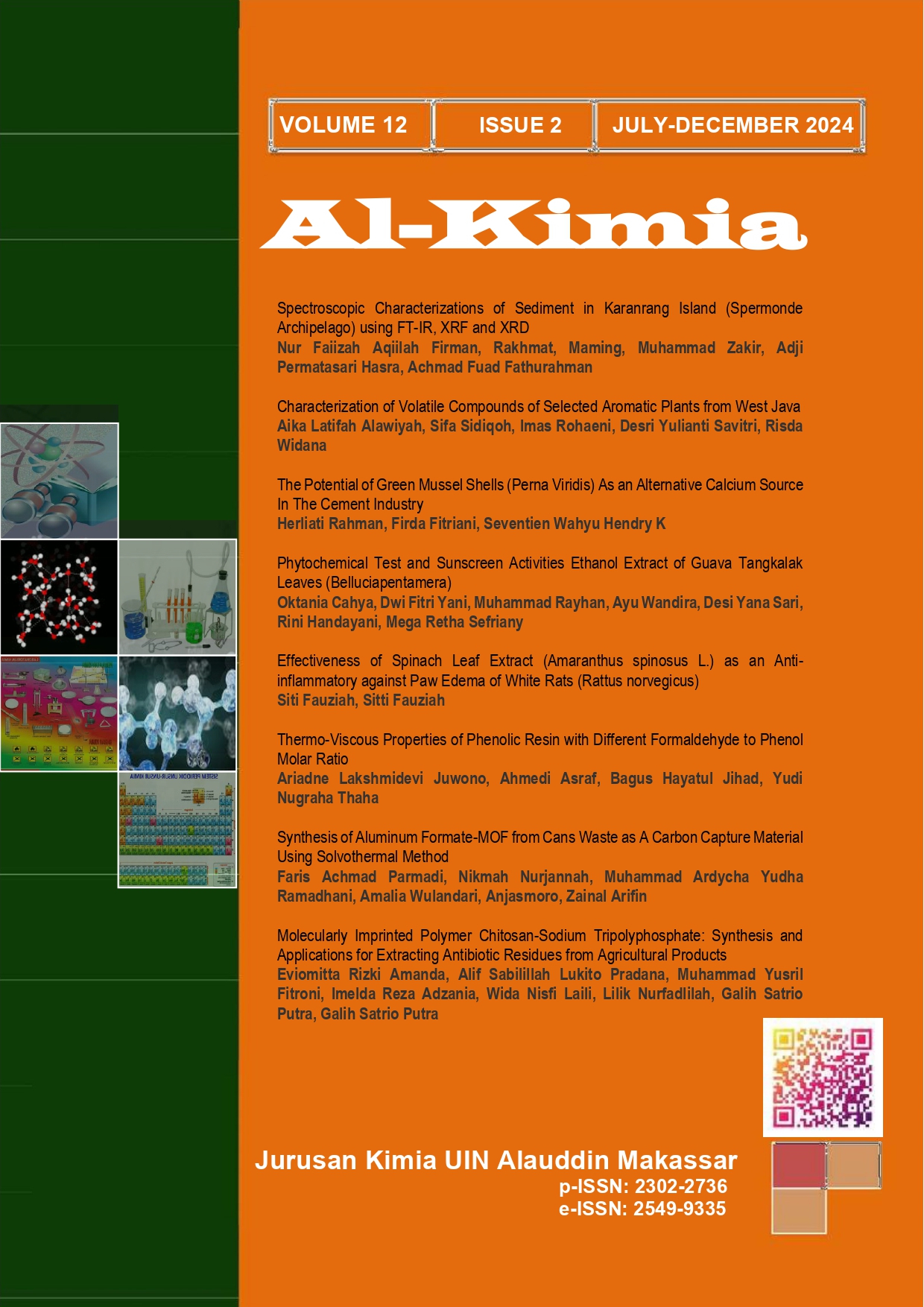Synthesis of Aluminum Formate-MOF from Cans Waste as A Carbon Capture Material Using Solvothermal Method
Abstract
This research aims to synthesize and characterize aluminum formate-metal organic framework (ALF-MOF) from beverage can waste using solvothermal method. The solvothermal method was chosen due to its ability to produce materials with controlled structures and superior properties. This research also uses a Central Composite Design (CCD) experimental design to optimize the synthesis conditions. The ALF-MOF synthesis process was carried out by mixing Al(OH)3 powder obtained from the extraction of aluminum in beverage can waste and HCOOH in DMF. The mixture was stirred and heated in an autoclave reactor at Al/HCOOH mole ratios (1:3, 1:5, and 1:7) and reaction times (1, 2, and 3 hours). Furthermore, the products were characterized using FTIR, XRD, SEM, and BET. Based on the results, it is known that the optimum synthesis conditions were achieved at the Al/HCOOH mole ratio and reaction time of 1:3.729 and 2.874 hours, respectively, with an ALF-MOF yield value of 87.71%. Characterization results showed the presence of COO groups and Al-O-Al groups. The ALF-MOF product also has an average particle diameter of 23.57 nm with a %crystallinity of 51.30% and a surface area of 128.507 m2/gram.
Downloads
References
Allangawi, A., Alzaimoor, E.F.H., Shanaah, H.A., Mohammed, A.A., Saqer, H., El-Fattah, A.A., Kamel, A.H. 2023. Carbon Capture Materials in Post-Combustion: Adsorption and Absorption-Based Processes. Journal of Carbon Research. 9(17): 1-29.
Ha, N.T.T., Thao, H.T., Ha, N.N. 2022. Physisorption and chemisorption of CO2 on Fe- MIL-88B derivatives: Impact of the functional groups on the electronic properties and adsorption tendency—A theoretical investigation. J. Mol. Graph. Model. 112.
Hasan, M.M.F., Zantye, M., Kazi, MK. 2022. Challenges and opportunities in carbon capture, utilization and storage: A process systems engineering perspective. Comput. Chem. Eng. 166.
Hassanpouryouzband, A., Joonaki, E., Edlmann, K., Haszeldine, R.S. 2021. Offshore Geological Storage of Hydrogen: Is This Our Best Option toAchieve Net-Zero?. ACS Energy Lett. 6(6): 2181–2186.
Manurung, M. dan Ayuningtyas, I.F. 2010. Kandungan aluminium dalam kaleng bekas dan pemanfaatannya dalam pembuatan tawas. Jurnal Kimia. 4(2): 180-186.
Qian, Q., Asinger, P.A., Lee, M.J., Han, G., Mizrahi, R.K., Lin, S., Benedetti, F.M.,Wu, A.X., Chi, W.S., Smith, Z.P. 2020. MOF-based membranes for gas separations. Chem. Rev. 120(16): 8161–8266.
Raganati, F., Miccio, F., Ammendola, P. 2021. Adsorption of Carbon Dioxide for Post- combustion Capture: A Review. Energy Fuels. 35: 12845−12868.
Rupam, T.H., Jahan, I., Palash, M.L., Harish, S. 2019. Green synthesis and adsorption characterisation of an aluminium based metal organic framework.Proceeding of 21ST Cross Straits Symposium on Energy and Environmental Science and Technology (CSS-EEST). November 2019, Shanghai, China.
Safaei, M., Foroughi, M.M., Ebrahimpor, N., Jahani, S., Omidi, A., Khatami, M. 2019. A review on metal-organic frameworks: Synthesis and applications. TrAC Trends Anal. Chem. 118.
Samanta, A., Zhao, A., Shimizu, G.K.H., Sarkar, P., Gupta, R. 2021. Post-Combustion CO2 Capture Using Solid Sorbents: A Review. Ind. Eng. Chem.Res. 51(4): 1438-1463.
SIPSN. 2023. Komposisi sampah. URL: https://sipsn.menlhk.go.id/sipsn/. Diakses tanggal 16 Januari 2024.
Witaryanto, T.S. dan Idzati, E.M. 2017. Inovasi Pembuatan Tawas Dari Limbah Kaleng Bekas. Tugas Akhir. Institut Teknologi Sepuluh Nopember.
Yang, G..P., Hou, L., Ma, L.F., Wang, Y Y. 2013. Investigation on the prime factors influencing the formation of entangled metal-organic frameworks. CrystEngComm. 15 (14), 2561– 2578.
Yusuf, V.Z., Malek, N.I., Kailasa, A.K. 2022. Review on Metal–Organic Framework Classification, Synthetic Approaches, and Influencing Factors: Applications in Energy, Drug Delivery, and Wastewater Treatment. ACS Omega. 7(49): 44507- 44531.
Authors who publish with this journal agree to the following terms:
1) Authors retain copyright and grant the journal right of first publication with the work simultaneously licensed under a Creative Commons Attribution License that allows others to share the work with an acknowledgement of the work's authorship and initial publication in this journal.
2) Authors are able to enter into separate, additional contractual arrangements for the non-exclusive distribution of the journal's published version of the work (e.g., post it to an institutional repository or publish it in a book), with an acknowledgement of its initial publication in this journal.
3)Authors are permitted and encouraged to post their work online (e.g., in institutional repositories or on their website) prior to and during the submission process, as it can lead to productive exchanges, as well as earlier and greater citation of published work (See The Effect of Open Access).


